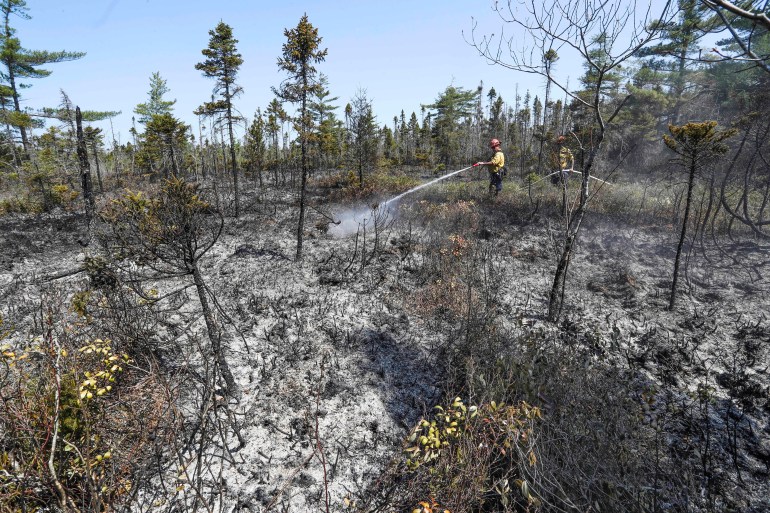Canada wildfires spread to new areas, prompting more evacuations
About 10,000 people have been ordered to leave a city in Quebec, amid hundreds of fires burning across the country.

Approximately 10,000 people have been ordered to leave a coastal city in the Canadian province of Quebec, marking the latest evacuation amid weeks of wildfires across the country.
The order on Friday for residents of Sept-Iles came after a nearby fire “advanced very quickly” overnight, according to the city’s mayor, Steeve Beaupre, who declared a local state of emergency.
Keep reading
list of 3 itemsWildfire forces thousands of people to evacuate in eastern Canada
Canada climate battle looms as Alberta takes aim at PM Trudeau
Bill Blair, the country’s minister of public safety, has said the ferocity of this year’s early wildfire season in Canada has been “unprecedented”, with more than 1,826 fires burning 2.7 million hectares (6.7 million acres) of land.
Across Canada, more than 210 fires were still burning on Friday, with about 29,000 people evacuated before the most recent order in Quebec, he said.

Stephane Lauzon, a member of Parliament from Quebec, told a news conference in Ottawa that about 100 fires were burning in the province — “many more than yesterday”.
“The situation is quickly changing in Quebec,” Lauzon said. Roughly 20 of those blazes were classified as out of control.
Ferocious fires have recently ravaged Nova Scotia on Canada’s Atlantic coast, after major flare-ups singed large swaths of the western provinces of Alberta, British Colombia and Saskatchewan in mid-May.
“This is a scary time for a lot of people from coast to coast to coast,” Prime Minister Justin Trudeau told reporters on Friday.
Wildfires are more common in Canada’s west, but blazes along the Atlantic coast have underscored the increasingly extreme weather the country has contended with in recent years amid rising global temperatures.
Approximately 200 homes were destroyed and nearly 20,000 residents have been displaced in Nova Scotia, where busloads of residents on Friday were taken on tours of the damage in the province’s largest city, Halifax.
Nova Scotia’s climate is heavily influenced by the North Atlantic Ocean, which typically brings higher humidity and more moderate temperatures than many other parts of the country.
While fires are not unusual, they tend to be much smaller than those in the west, with the region buffered in part by the vast Acadian Forest of broadleaf trees that are less flammable than other species.
However, speaking to the Reuters news agency, Weather Network meteorologist Michael Carter said that the region received low snowfall over the winter, followed by an exceptionally dry spring, contributing to the current blazes.
Ellen Whitman, a research scientist with the Canadian Forest Service, told the news agency that — while it is difficult to determine the impact of climate change on a single fire season — Canada’s Atlantic provinces have been much hotter than usual. Scientists expect temperatures in the region to continue to rise in coming years.
Across Canada, the land burned by wildfires in 2023 is more than 10 times the average typically burned by this time of year, Minister of Public Safety Blair said on Friday, referencing data points from the past decade.
At least 93 of the active fires in the country were still labelled as out of control, he said, adding that 1,000 firefighters from Australia, New Zealand, South Africa and the United States have arrived or were en route to bolster firefighting efforts.
Ottawa has also started to deploy the military in Nova Scotia to help, he said.
“The situation remains severe across the country,” Blair said.
Weather forecasts show a period of cooler, wetter air was moving into Canada’s Atlantic regions on Friday, with experts hoping the conditions will provide a reprieve from the flames.